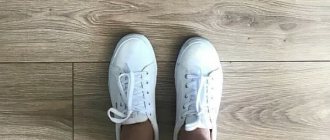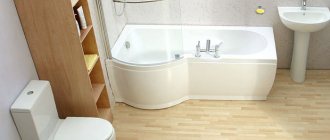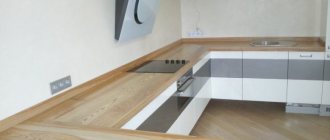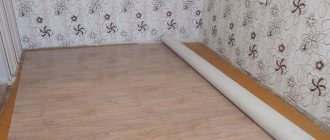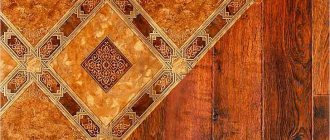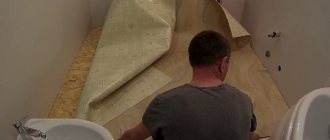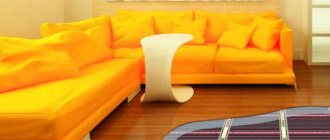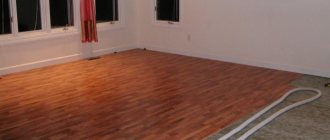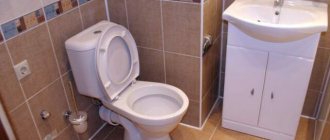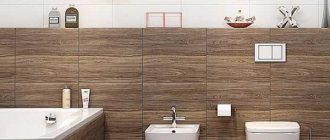No flooring lasts forever. It wears out, and in order for the room to return to its fresh look, it will need to be replaced. The most common coating for this is linoleum, which is attractive due to its price, wear resistance, design and practicality. However, not everyone knows how to glue linoleum.
- Which is better to choose linoleum for an apartment?
- Where can you glue linoleum
- On concrete
- On a wooden floor
- To plywood
- Instructions on how to glue
- How to glue linoleum at joints: several methods
- Glue gun
- Soldering iron
- Hot welding
- Cold welding
- Adhesive mastic
- Overlay strip for linoleum
- Common mistakes when gluing
- Care instructions
You can glue linoleum to the floor yourself, without repair specialists. Before doing this, we recommend watching video tutorials in order to properly glue the material together and make the joints completely invisible and airtight.
This article is devoted to the rules for gluing linoleum so that it lasts for several decades. It covers:
- types of coverage;
- where can you glue;
- what glue for linoleum is needed in the work;
- methods of gluing at joints;
- recommendations for proper care.
Which is better to choose linoleum for an apartment?
Which linoleum is best for an apartment? Manufacturers produce two types of coating:
- Natural. The classic type, which is made from a resin mixture, flax oil, wood flour, wax and other natural ingredients. All these fillers are mixed in construction mixers, turning into a viscous mass similar to dough. This mixture is rolled out onto a fabric base (for example, linen or jute). This coating is safe for health, environmentally friendly and expensive.
- PVC. Household PVC linoleum is made from thermoplastics coated with a protective layer. Often the base is foamed PVC, while other brands have synthetic felt. Durable, resistant to mechanical damage, easy to maintain and resistant to moisture.
Characteristics of individual types of glue
Water-dispersible preparations are used only on substrates that absorb moisture. They are applied to a self-leveling screed, concrete and wood substrate. Polyvinyl chloride materials are highly moisture resistant, so it would not be advisable to use water-dispersion glue to glue new linoleum and old (as a substrate). The reaction preparation for seams contains polyurethane and epoxy resin. When applied, it chemically interacts with the base, turning the joints of the coating into a hermetically sealed seam. Among its disadvantages are fire and explosion hazards, toxic fumes.
It is not recommended to use preparations for PVC coatings for the purpose of adhesion of natural materials. The main characteristic of the adhesive for laying natural flooring is its almost zero water content, which cannot affect the quality of the product. The material of this category is quite sensitive to excess moisture; under its influence, deformation occurs. To level out deformation phenomena and ensure strong bonding, a strong-fixing adhesive is used for linoleum joints.
The size of the room affects the consumption of adhesive. In rooms larger than 20 m2 and in high-traffic areas (corridors), it is advisable to ensure full adhesion. In small rooms, there are no difficulties with finishing joints, since the covering is laid in a single strip of the selected width. But sometimes it is necessary to fasten several separate canvases in the contact zone. This is due to the fact that during operation the coating here quickly peels off and swells, which is not only not aesthetically pleasing, but also dangerous, and requires the linoleum to be glued on.
Household adhesives are selected mainly for adhesion to pile, fine mesh and fabric substrates. Commercial - when laying heterogeneous (layered) and homogeneous (1-layer) material.
Where can you glue linoleum
Before gluing linoleum, you need to choose the right coating. This material interacts with almost all floor surfaces, but there are some nuances.
Despite the compatibility of linoleum with most flooring materials, it cannot be glued with any glue. Adhesion will be strong only if the adhesive is chosen correctly.
On concrete
The material is compatible with concrete. The coating will last a long time and for at least five years. However, for this, the floor must be flat, without depressions or protrusions.
The main danger of a concrete floor is the presence of dust on it. It is this that impairs the adhesion of the glue, and the glued canvas will hold less firmly. Therefore, the main task of the master is to thoroughly clean the concrete from dust and debris.
On a wooden floor
It is less difficult to install the coating correctly on a wooden floor. It is easier to remove debris, dirt, and dust from wood, which means adhesion to it will be better.
We recommend sanding the wooden covering before laying linoleum. This will level the surface and remove the smallest imperfections.
To plywood
Plywood (PC) is a fragile material. It is not characterized by a high tendency to adhesion, so we do not recommend gluing anything to it.
But if sizing on the FC is still necessary, it must first be cleaned and dried. We recommend gluing it with a special compound or using liquid nails.
Requirements for choosing plywood
The area of application of plywood can be determined by its grade. According to state standards, there are five grades of plywood, the gradation of grade affects the formation of the price - the higher the grade of the material, the higher the price.
In order to stay within your budget, you should determine what type of plywood you need to use before starting work.
The grade of plywood is determined based on the following criteria:
- The material obtained during the process of setting up equipment for the production process is of low quality and contains defects. This type of plywood can be used as a subfloor and then covered with high-quality plywood. This plywood is determined by grade IV.
- A material with fewer defects that cannot be used for finishing flooring is grade III plywood.
- Material with cracks (up to 20 cm) is laid under linoleum, but with preliminary putty in the places of cracks - this is grade II plywood.
- A material that can be used for any purpose, also as a finishing flooring, is grade I plywood (small cracks up to 20 mm are acceptable).
- A high-quality material with a high degree of surface finishing, suitable not only for finishing flooring, but also for the manufacture of decorative elements - this is elite plywood E.
By marking plywood, you can determine its operational purpose. So, for arranging the flooring, urea plywood with the FK marking is used - a moisture-resistant material, environmentally friendly.
Taking into account price formation, products can be grouped into four types:
- Laminated;
- With double-sided processing (Ш2);
- With one-sided processing (Ш1);
- Unpolished.
The thickness of plywood ranges from 3-30 mm; 12-16 mm is used for flooring. If a large thickness of the flooring is required, lay it in several rows. The manufactured plywood products of the FK brand have dimensions of 1500x3000 mm.
Instructions on how to glue
How to lay linoleum correctly? You need to follow step-by-step instructions that describe in detail the principles of operation. This will help you avoid basic mistakes in your work.
The master, who is faced with the task of gluing linoleum, must choose one of several working methods. Their distribution is based on the type of adhesive used in the work.
Preparatory activities before installation
There are truly an unimaginable number of linoleum brands on the market now. A practical, aesthetic floor covering is produced with an insulating backing and without a fleecy back surface. A lot of colorful, structural, and texture variations have been proposed, but the democratic pricing is more convincing than other arguments for the choice of owners. However, for those who asked the finishers the question “how much does it cost to lay linoleum,” the enthusiasm for some reason fades slightly. Prices sometimes exceed the cost of the material itself (300-450 rubles).
How to glue linoleum at joints: several methods
The main problem with this material is the likelihood of separation at the seams. Therefore, the master is faced with the question of how to glue linoleum at the level of its joints.
The most common method is fastening with thresholds made of plastic or aluminum. If this technique is not suitable, we recommend using hot or cold welding. However, there are alternatives to it.
Glue gun
This gluing machine is sold at any office supply or building materials store. It connects directly to the network, heating the adhesive composition.
The instructions are quite simple:
- the edges of the material are cut to the base and cleaned of dust;
- glue is filled into the gun and the tool is plugged into an outlet;
- the heated compound fills the joints;
- until it completely hardens, you can remove its remains;
The following mixtures can interact with the coating:
- A is a universal option for sealing joining strips.
- B – to restore the old coating. Effectively fills recesses and levels the surface.
- C – for industrial use. Copes with joining polyester products.
Soldering iron
An outdated method, but it is still used by craftsmen. Suitable for removing a small number of small joints.
The soldering iron heats the edges of the canvas, they melt and connect to each other. The seam created after hardening can be carefully trimmed. An unpleasant drawback is the visibility of the seam, which often differs from the color of the coating. Therefore, this method is absolutely not suitable for light-colored coatings.
Hot welding
The seam can also be welded by hot welding. This method can only be used by specialists with experience in this type of work. It is more rational to use it if you need to eliminate seams in a thick coating.
For work, prepare the following equipment:
- Construction hair dryer with heating attachment.
- Cutters or milling machine.
- Cords match the color of the coating.
- Knife for removing residues.
We recommend choosing a hairdryer with significant power. Its task will be to heat the canvas to a temperature of 500-600 degrees Celsius. This device is equipped with a special sensor for temperature control.
The canvases are glued to the base using PVA to immobilize them. A hairdryer heats up the canvas, melting the joints and connecting them to each other as they harden. It must be remembered that the method is complex. It requires skills in working with hot materials.
Cold welding
This is one of the simple and effective ways to process edges. For him, stock up on the following equipment:
- transparent glue for welding;
- knife or scissors;
- masking tape.
Masking tape is applied to the front and back surfaces. The canvases are tightly fitted to each other, filling the seam. Then the product is allowed to dry for ten minutes, and the tape is removed. The composition will dry completely only after two hours.
Adhesive mastic
Applying mastic is the easiest method to seal seams. Upon contact with air, it hardens, forming a tight and durable connection.
The paste for gluing seams is practically harmless to use, but we recommend that the craftsman wear protective gloves. It is elastic, so it is easy to seal even the smallest joints.
Overlay strip for linoleum
Linoleum does not need to be glued. It can be connected with clamping strips made of metal or plastic. This creates a more aesthetic junction between materials with different structures. For example, this option is suitable for creating a transition between it and the laminate.
Overlay strips are the most successful solution for organizing a smooth transition between rooms and from one floor covering to another. They are inexpensive, easy to fix at the joint, even without preparation. Among the disadvantages, it should be noted that such an overlay will protrude above the linoleum covering.
Surface preparation
One of the necessary conditions for proper operation concerns the plywood base itself. It is important that the floor remains stable, that is, the plywood is screwed on with self-tapping screws and lies there for several days (at least three). After which the linoleum is cut around the perimeter of the room with a temper and left for a couple of days. Only then do they glue the joints first and, if the situation requires it, the entire base of the linoleum to the plywood.
Pay attention to the temperature in the room; it must be maintained at more than 20 °C. The surface of the plywood is degreased and cleaned of dirt and possible dust. Particularly difficult in the gluing process are the joints. There are hard-wearing brands of flooring, designed mainly for interconnection. In these cases, precise markings of the canvases are made, and the linoleum is laid and smoothed with a roller onto the plywood.
Common mistakes when gluing
Incorrect gluing leads to poor-quality repairs. If the master does not follow the work algorithm, he has to figure out why the linoleum moves in waves and does not stay in place.
There are several reasons. This may be a poor-quality composition that no longer provides strong adhesion. Other problems may arise due to the fact that the surface was not properly cleaned before gluing. Any dirt or dust impairs adhesion and prevents the materials from bonding tightly.
Masters advise following these working rules:
- you need to work in rubber or latex gloves;
- it is advisable to use a mask or respirator;
- the adhesive seam must be uniform;
- there is no need to quickly remove excess - it is better to wait for the seam to dry completely so that it does not peel off;
- Having chosen the cold welding method, you need to make sure that the composition is driven deep into the seam.
Practical recommendations
In the process of work, several questions arise about the alternative and methods of gluing, that is, the sequence. We present some of them, since they are equally applicable to the surface of wood boards, for example, chipboard. Linoleum intended for cutting joints can be fixed with double-sided tape. In this case, only a covering with a uniform base is suitable, with the exception of felt and fabric types.
Where flooring panels are to be cut for joining, ensure that the base of the plywood is level. These may be damaged or chipped; they must first be puttied and allowed to dry completely. Otherwise, the glue at the joints may wrinkle and push the glued seam apart. The same applies to screws sticking out in the floor at the cutting points; installing linoleum on a plywood floor will be difficult, since it will be impossible to secure the joint evenly.
